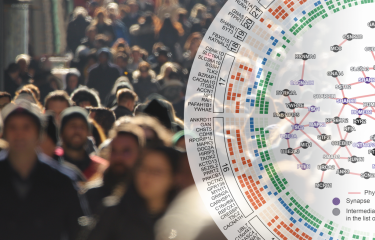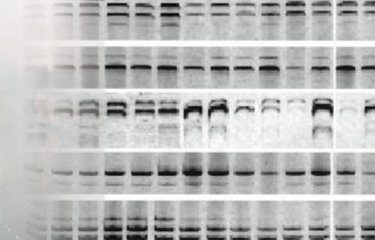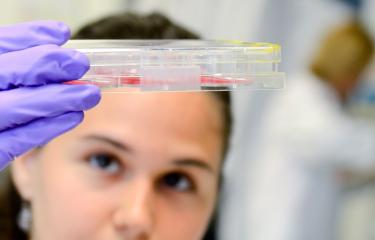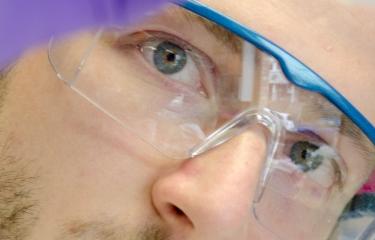A group of the Pasteur Institute has identified a new susceptibility gene for autism. The key role of this gene in melatonin synthesis sheds light on this complex condition. This work is published in the journal Molecular Psychiatry.
Press release
Paris, may 15, 2007
Autism is a complex syndrome, which appears before 3 years of age, and is characterised by deficits in social interactions and communication, associated to repetitive and stereotyped behaviours. Autism spectrum disorders (ASD) affect one child in 200, with a frequency four times higher among males. In 2003, then in 2006, two studies undertaken by the group of Thomas Bourgeron at the Pasteur Institute (see press release of March 31, 2003 and December 18, 2006) identified, in a limited number of affected individuals, mutations in three genes (NLGN3, NLGN4 and SHANK3) involved in the formation/maintenance of synapses (communication between the neurons).
This group at the Pasteur Institute was also interested in a region shared by the X and Y chromosomes, called the pseudoautosomal region 1 (PAR1). Deletions of the PAR1 region had been previously reported in patients with ASD, but the causative gene(s) were not identified.
In collaboration with INSERM, Robert Debré hospital, Albert Chenevier hospital, and the department of psychiatry of the university of Gothenburg (Sweden), the group of the Thomas Bourgeron studied one gene in PAR1, named ASMT. This gene encodes an enzyme involved in melatonin synthesis. Melatonin is produced mainly during the night by the pineal gland and plays a crucial role in the regulation of the circadian (night/day) rhythms, such as the sleep-wake cycles. A low level of melatonin has been previously reported in individuals with ASD by three independent groups, but the cause remained unknown. In this new study, the researchers observed that more than half of the children with ASD had low blood melatonin level (less than half of the control value) and this low concentration was correlated with a deficit of the ASMT enzyme activity. Consistent with these functional studies, mutations of the ASMT gene, contributing to low expression and/or low ASMT activity, were identified in several families.
The authors insist on the fact that the presence of low melatonin levels in an individual does not necessarily lead to autism and cannot be considered as a diagnostic test for this condition. Indeed, several parents of children with autism also have low melatonin levels, although they do not have autism. Thus, the consequences of low melatonin levels on brain function and development remain to be specified. The scientists hypothesize that low melatonin could have a direct role on the modulation of neuronal networks and thus could amplify the effect of other genetic mutations in affected individuals. Melatonin could also affect circadian rhythms and sleep-wake cycles, making the children more vulnerable to other still unidentified susceptibility factors. Indeed, sleep problems are very frequent in individuals with autism and two recent studies show that the use of melatonin seems to improve sleep.
More than ever, the search for genes involved in the susceptibility to autism requires the collaboration of the families to better continue these new research avenues and identify the origins of these complex disorders.
This study was undertaken with the support of the Institute Pasteur, Inserm, Assistance Publique-Hôpitaux de Paris, Fondation France Telecom, Fondation de France, Fondation pour la Recherche Médicale, the 6th framework of European Research, Fondation biomédicale de la Mairie de Paris, Fondation NRJ, Cure Autism Now and Swedish Science Council.
Sources
(1) Voir communiqués de presse du 31 mars 2003 et 18 décembre 2006
2) " Abnormal melatonin synthesis in autism spectrum disorders" : Molecular Psychiatry, en ligne 15 mai 2007.
J Melke1, HG Botros (1), P Chaste (1), C Betancur (2), G Nygren (3), H Anckarsäter (3,4), M Rastam (3), O Stahlberg (3), IC Gillberg (3), R Delorme (1), N Chabane (5), M-C Mouren-Simeoni (5), F Fauchereau (1), CM Durand (1), F Chevalier (1), X Drouot (6), C Collet (7), J-M Launay (7), M Leboyer (2,8), C Gillberg (3,9), T Bourgeron (1,10) and the PARIS study
1. Groupe Génétique humaine et fonctions cognitives, Institut Pasteur, Paris
2. Inserm U513, Université Paris XII, Créteil
3. Department of Child and Adolescent Psychiatry, Göteborg University, Suède
4. Institute of Clinical Sciences, Lund University, Malmö, Suède
5. Service de Psychopathologie de l’Enfant et de l’Adolescent, hôpital Robert Debré, Assistance Publique-Hôpitaux de Paris, France
6. Service de Physiologie-Explorations Fonctionnelles, hôpital Henri Mondor, Créteil
7. Service de Biochimie, IFR 139, hôpital Lariboisière, AP-HP, EA 3621, Faculté de Pharmacie, Paris
8. Département de Psychiatrie, hôpital Henri Mondor et Albert Chenevier, AP-HP, Créteil
9. Saint George’s Hospital Medical School, Londres, Royaume-Uni
10. Université Denis Diderot Paris 7, Paris
Contact presse
Service de presse de l’Institut Pasteur
Nadine Peyrolo ou Corinne Jamma
01 40 61 33 41
cjamma@pasteur.fr







